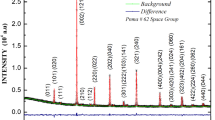Abstract
Crystalline films (thickness ∼1 μm) of Prussian blue-based molecular magnets, synthesized using electrochemical method at two different reduction potentials −0.5 and −0.9 V, result into K0.1CrII 1.45[CrIII(CN)6] · mH2O (film 1) and K0.8CrII 1.1[CrIII(CN)6] · mH2O (film 2), respectively. The structural and magnetic properties of such films are investigated using atomic force microscopy (AFM), X-ray diffraction (XRD), infrared (IR) spectroscopy, and dc magnetization measurements. The film morphology, examined using AFM, shows uniformly distributed triangular crystallites over the substrate surface. The presence of CrIII–C≡N–CrII sequence, in the range of 1,900 to 2,300 cm−1 in IR spectra, confirms formation of Prussian blue analogues. The XRD results reveal information about the crystalline nature of the films and the relative intensities of the Bragg peaks change with the K+ ions. The exchange interaction between Cr ions through C≡N ligand confirms that the electron transfer from C≡N molecule to Cr ions is ferrimagnetic in nature. The high Curie temperatures (T C) are found to be ∼195 and ∼215 K for film 1 and film 2, respectively. The higher value of T C is attributed to the inclusion of more K+ ions for film 2, resulting decreases in the CrIII(C≡N)6 vacancies and increases in the number of nearest neighbors of CrII ions. The branching in the zero field-cooled and field-cooled magnetization data below Curie temperature is explained in terms of kinetic behavior of magnetic domains with different cooling conditions and the presence of water molecule vacancies in the lattice.







Similar content being viewed by others
References
Sato O, Lyoda T, Fujishima A, Hashimoto K (1996) Photoinduced magnetization of a cobalt–iron cyanide. Science 272:704–705
Shimamoto N, Ohkoshi S, Sato O, Hashimoto K (2002) Control of charge-transfer-induced spin transition temperature on cobalt−iron Prussian blue analogues. Inorg Chem 41:678–684
Coronado E, Giménez-López MC, Korzeniak T, Levchenko G, Romero FM, Segura A, García-Baonza V, Cezar JC, de Groot FMF, Milner A, Paz-Pasternak M (2008) Pressure-induced magnetic switching and linkage isomerism in K0.4Fe4[Cr(CN)6]2.8 · 16H2O: X-ray absorption and magnetic circular dichroism studies. J Am Chem Soc 130:15519–15532
Tokoro H, Ohkoshi S-i (2011) Novel magnetic functionalities of Prussian blue analogs. Dalton Trans 40:6825–6833
Mallah T, Thiebaut S, Verdaguer M, Veillet P (1993) High-Tc molecular-based magnets: ferrimagnetic mixed-valence chromium(lil)-chromium(ll) cyanides with Tc at 240 and 190 Kelvin. Science 262:1554–1557
Ferlay S, Mallah T, Ouhes R, Veillet P, Verdaguer M (1995) A room-temperature organometallic magnet based on Prussian blue. Nature 378:701–703
Sato O, Lyoda T, Fujishima A, Hashimoto K (1996) Electrochemically tunable magnetic phase transition in a high-Tc chromium cyanide thin film. Science 271:49–51
Sato O, Hayami S, Einaga Y, Gu Z-Z (2003) Control of the magnetic and optical properties in molecular compounds by electrochemical, photochemical and chemical methods. Bull Chem Soc Jpn 76:443–470
Buschmann WE, Paulson SC, Wynn CM, Girtu MA, Epstein AJ, White HS, Miller JS (1998) Reversed (negative) magnetization for electrochemically deposited high-Tc thin films of chromium hexacyanide magnets. Chem Mater 10(5):1386–1395
Coronado E, Makarewicz M, Prieto-Ruiz JP, Prima-García H, Romero FM (2011) Magneto-optical properties of electrodeposited thin films of the molecule-based magnet Cr5.5 (CN)12 · 11.5H2O. Adv Mater 23:4323–4326
Nakanishi S, Lu G, Kothari HM, Bohannan EW, Switzer JA (2003) Epitaxial electrodeposition of Prussian blue thin films on single-crystal Au(110). J Am Chem Soc 125:14998–14999
Horcas I, Fernandez R, Gomez-Rodriguez JM, Colchero J, Gomez-Herrero J, Baro AM (2007) WSXM: a software for scanning probe microscopy and a tool for nanotechnology. Rev Sci Instrum 78:013705–013712
Bleuzen A, Lomenech C, Escax V, Villain F, Varret F, Cartier dit Moulin C, Verdaguer M (2000) Photoinduced ferrimagnetic systems in prussian blue analogues CIxCo4[Fe(CN)6]y (CI = alkali cation). 1. Conditions to observe the phenomenon. J Am Chem Soc 122(28):6648–6652
Bhatt P, Yusuf SM, Mukadam MD, Yakhmi JV (2010) Enhancement of Curie temperature in electrochemically prepared crystalline thin films of Prussian blue analogs K j FeII k [CrIII(CN)6] l ⋅ mH2O. J Appl Phys 108:023916–023921
Rodriguez-Carvajal J FULLPROF, November 2007, website: http://www.ill.eu/sites/fullprof/.
Nakamoto K (1997) Infrared and raman spectra of inorganic and coordination compounds. Part B: applications in coordination, organometallic and bioinorganic chemistry, 5th edn. Wiley-Interscience, New York
Kumar A, Yusuf SM, Keller L, Yakhmi JV, Srivastava JK, Paulose PL (2007) Variation of structural and magnetic properties with composition in the (CoxNi1−x)1.5[Fe(CN)6] • zH2O series. Phys Rev B 75:224419–224429
Brown DB, Shriver DF, Schwartz LH (1968) Solid-state reactions of iron(II) hexacyanochromate(III). Inorg Chem 7:77–83
Ohkoshi S-i, Lyoda T (1997) Magnetic properties of mixed ferro-ferrimagnets composed of Prussian blue analogs. Phys Rev B 56:11642–11652
Mukadam MD, Kumar A, Yusuf SM, Yakhmi JV, Tewari R, Dey GK (2008) Spin-glass behavior in ferromagnetic Fe[Fe(CN)6] • xH2O nanoparticles. J Appl Phys 103:123902–123907
Mukadam MD, Yusuf SM, Sharma P, Kulshreshtha SK, Dey GK (2005) Dynamics of spin clusters in amorphous Fe2O3. Phys Rev B 72:174408–174414
Kosaka W, Tozawa M, Hashimoto K, Ohkoshi S-i (2006) Synthesis and superparamagnetic property of a Co–Cr Prussian blue analogue nanoparticles inside Nafion membrane. Inorg Chem Commun 9:920–922
Catala L, Gloter A, Stephan O, Rogez G, Mallah T (2006) Superparamagnetic bimetallic cyanide-bridged coordination nanoparticles with TB = 9 K. Chem Commun (9) 1018-1020
Kumar A, Yusuf SM, Keller L (2005) Structural and magnetic properties of FeFeCN6 · 4H2O. Phys Rev B 71:054414–054420
Acknowledgment
Authors would like to thank Mr. P. Jha for the IR measurements.
Author information
Authors and Affiliations
Corresponding author
Rights and permissions
About this article
Cite this article
Bhatt, P., Yusuf, S.M., Bhatt, R. et al. Magnetic properties of electrochemically prepared crystalline films of Prussian blue-based molecular magnets K j CrII k [CrIII(CN)6] l · mH2O. J Solid State Electrochem 17, 1285–1293 (2013). https://doi.org/10.1007/s10008-012-1995-x
Received:
Revised:
Accepted:
Published:
Issue Date:
DOI: https://doi.org/10.1007/s10008-012-1995-x




